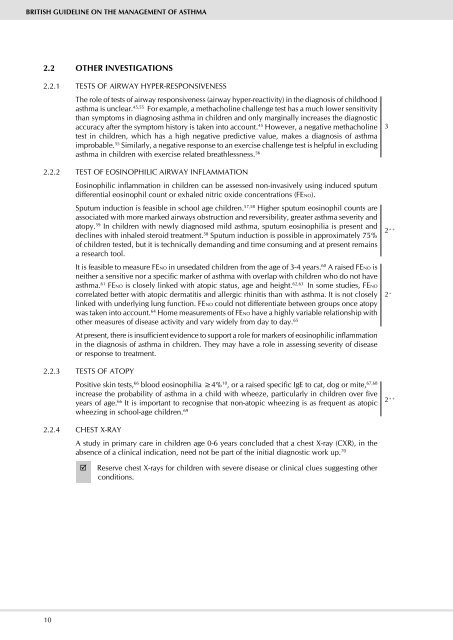sign101
sign101
sign101
You also want an ePaper? Increase the reach of your titles
YUMPU automatically turns print PDFs into web optimized ePapers that Google loves.
British Guideline on the MAnAGeMent of AsthMA<br />
2.2 other investiGAtions<br />
2.2.1 TESTS OF AIRWAy HyPER-RESPONSIvENESS<br />
10<br />
The role of tests of airway responsiveness (airway hyper-reactivity) in the diagnosis of childhood<br />
asthma is unclear. 45,55 For example, a methacholine challenge test has a much lower sensitivity<br />
than symptoms in diagnosing asthma in children and only marginally increases the diagnostic<br />
accuracy after the symptom history is taken into account. 45 However, a negative methacholine<br />
test in children, which has a high negative predictive value, makes a diagnosis of asthma<br />
improbable. 55 Similarly, a negative response to an exercise challenge test is helpful in excluding<br />
asthma in children with exercise related breathlessness. 56<br />
2.2.2 TEST OF EOSINOPHILIC AIRWAy INFLAMMATION<br />
Eosinophilic inflammation in children can be assessed non-invasively using induced sputum<br />
differential eosinophil count or exhaled nitric oxide concentrations (FENO).<br />
Sputum induction is feasible in school age children. 57,58 Higher sputum eosinophil counts are<br />
associated with more marked airways obstruction and reversibility, greater asthma severity and<br />
atopy. 59 In children with newly diagnosed mild asthma, sputum eosinophilia is present and<br />
declines with inhaled steroid treatment. 58 Sputum induction is possible in approximately 75%<br />
of children tested, but it is technically demanding and time consuming and at present remains<br />
a research tool.<br />
It is feasible to measure FENO in unsedated children from the age of 3-4 years. 60 A raised FENO is<br />
neither a sensitive nor a specific marker of asthma with overlap with children who do not have<br />
asthma. 61 FENO is closely linked with atopic status, age and height. 62,63 In some studies, FENO<br />
correlated better with atopic dermatitis and allergic rhinitis than with asthma. It is not closely<br />
linked with underlying lung function. FENO could not differentiate between groups once atopy<br />
was taken into account. 64 Home measurements of FENO have a highly variable relationship with<br />
other measures of disease activity and vary widely from day to day. 65<br />
At present, there is insufficient evidence to support a role for markers of eosinophilic inflammation<br />
in the diagnosis of asthma in children. They may have a role in assessing severity of disease<br />
or response to treatment.<br />
2.2.3 TESTS OF ATOPy<br />
Positive skin tests, 66 blood eosinophilia ≥4% 10 , or a raised specific IgE to cat, dog or mite, 67,68<br />
increase the probability of asthma in a child with wheeze, particularly in children over five<br />
years of age. 66 It is important to recognise that non-atopic wheezing is as frequent as atopic<br />
wheezing in school-age children. 69<br />
2.2.4 CHEST x-RAy<br />
A study in primary care in children age 0-6 years concluded that a chest x-ray (CxR), in the<br />
absence of a clinical indication, need not be part of the initial diagnostic work up. 70<br />
; Reserve chest x-rays for children with severe disease or clinical clues suggesting other<br />
conditions.<br />
3<br />
2 ++<br />
2 +<br />
2 ++


